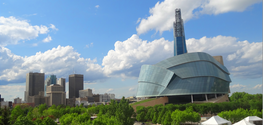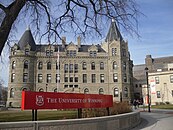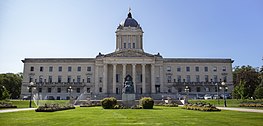Template:Featured article is only for Wikipedia:Featured articles.
Winnipeg | |
|---|---|
| City of Winnipeg Ville de Winnipeg (French) | |
From top, left to right: Winnipeg panorama featuring the Canadian Museum for Human Rights, Wesley Hall at the University of Winnipeg, Downtown Winnipeg, Saint Boniface Cathedral, Esplanade Riel bridge and the Manitoba Legislative Building | |
|
[[File:|border|100x100px|Official logo of Winnipeg]] | |
| Nicknames: | |
| Motto(s): | |
Location within Manitoba | |
| Coordinates: 49°53′4″N 97°8′47″W / 49.88444°N 97.14639°W | |
| Country | Canada |
| Province | Manitoba |
| Region | Winnipeg Metro Region |
| Incorporated | 1873 |
| Government | |
| • Mayor | Brian Bowman |
| • Governing body | Winnipeg City Council |
| Area | |
| • Land | 464.09 km2 (179.19 sq mi) |
| • Metro | 5,306.79 km2 (2,048.96 sq mi) |
| Elevation | 239 m (784 ft) |
| Population | |
| • Provincial capital city | 705,244 (7th) |
| • Density | 1,430/km2 (3,700/sq mi) |
| • Urban | 705,244 (7th) |
| • Urban density | 1,429/km2 (3,700/sq mi) |
| • Metro | 778,489 (8th) |
| • Metro density | 146.70/km2 (380.0/sq mi) |
| Demonym | Winnipegger |
| Time zone | UTC−6 (CST) |
| • Summer (DST) | UTC−5 (CDT[9]) |
| Area code(s) | 204 and 431 |
| Website | www |
Winnipeg (/ˈwɪnɪpɛɡ/ ) is the capital and largest city of the province of Manitoba in Canada. It is centred on the confluence of the Red and Assiniboine rivers, near the longitudinal centre of North America.
The city is named after the nearby Lake Winnipeg; the name comes from the Western Cree words for muddy water. The region was a trading centre for Indigenous peoples long before the arrival of Europeans. French traders built the first fort on the site in 1738. A settlement was later founded by the Selkirk settlers of the Red River Colony in 1812, the nucleus of which was incorporated as the City of Winnipeg in 1873. As of 2016[update], Winnipeg is the seventh most populated municipality in Canada, with a resident population of about 778,500.[5] Being far inland, the local climate is extremely seasonal even by Canadian standards with average January lows of around −21 °C (−6 °F) and average July highs of 26 °C (79 °F).
Known as the "Gateway to the West", Winnipeg is a railway and transportation hub with a diversified economy. This multicultural city hosts numerous annual festivals, including the Festival du Voyageur, the Winnipeg Folk Festival, the Jazz Winnipeg Festival, the Winnipeg Fringe Theatre Festival, and Folklorama. Winnipeg was the first Canadian host of the Pan American Games. It is home to several professional sports franchises, including the Winnipeg Blue Bombers (Canadian football), the Winnipeg Jets (ice hockey), Manitoba Moose (ice hockey), Valour FC (soccer), and the Winnipeg Goldeyes (baseball).
xxxxxxxxx
Climate
editWinnipeg's location in the Canadian Prairies gives it a warm-summer humid continental climate[10] (Köppen Dfb),[11] with warm, humid summers, and long, severely cold winters. Summers have a July mean average of 19.7 °C (67.5 °F).[4] Winters are the coldest and driest time of year, with the January mean average around −16.4 °C (2.5 °F) and total winter precipitation (December through February) averaging 55.2 mm (2.17 in).[4] Temperatures occasionally drop below −40.0 °C (−40 °F).[4]
On average there are 317.8 days per year with measurable sunshine, with July seeing the most on average.[12] With 2353 hours of sunshine per year, Winnipeg is the second sunniest city in Canada.[13] Total annual precipitation (both rain and snow) is just over 52 centimetres (20 in).[4] Thunderstorms are very common during summer, and sometimes severe enough to produce tornadoes.[14] Low wind chill values are a common occurrence in the local climate. The wind chill has gone down as low as −57 °C (−70.6 °F) and on average there are twelve days of the year that can reach a wind chill below −40 °C (−40 °F).[4]
The highest temperature ever recorded in Winnipeg was 42.2 °C (108 °F) on 11 July 1936 while the highest daily low temperature was 28.3 °C (82.9 °F) on 12 July 1936.[15] The apparent heat can be even more extreme due to bursts of humidity, and on 25 July 2007 a humidex reading of 47.3 °C (117.1 °F) was measured. [4]
xxxxx
The frost-free season is comparatively long for a location with such severe winters. The last spring frost is on average around 23 May, whilst the first fall frost is on 22 September.[4]
| Climate data for Winnipeg (Winnipeg James Armstrong Richardson International Airport) WMO ID: 71852; coordinates 49°55′N 97°14′W / 49.917°N 97.233°W; elevation: 238.7 m (783 ft); 1991–2020 normals, extremes 1872–present[a] | |||||||||||||
|---|---|---|---|---|---|---|---|---|---|---|---|---|---|
| Month | Jan | Feb | Mar | Apr | May | Jun | Jul | Aug | Sep | Oct | Nov | Dec | Year |
| Record high humidex | 6.3 | 11.1 | 28.0 | 34.1 | 40.2 | 46.1 | 47.3 | 45.5 | 45.9 | 34.3 | 23.9 | 9.3 | 47.3 |
| Record high °C (°F) | 7.8 (46.0) |
11.7 (53.1) |
23.7 (74.7) |
34.3 (93.7) |
37.8 (100.0) |
38.3 (100.9) |
42.2 (108.0) |
40.6 (105.1) |
38.8 (101.8) |
31.1 (88.0) |
23.9 (75.0) |
11.7 (53.1) |
42.2 (108.0) |
| Mean daily maximum °C (°F) | −11.4 (11.5) |
−8.8 (16.2) |
−0.9 (30.4) |
10.0 (50.0) |
18.1 (64.6) |
23.3 (73.9) |
25.8 (78.4) |
25.4 (77.7) |
19.6 (67.3) |
10.4 (50.7) |
0.1 (32.2) |
−8.2 (17.2) |
8.6 (47.5) |
| Daily mean °C (°F) | −16.3 (2.7) |
−14.1 (6.6) |
−6.1 (21.0) |
3.8 (38.8) |
11.1 (52.0) |
17.1 (62.8) |
19.5 (67.1) |
18.7 (65.7) |
13.3 (55.9) |
5.1 (41.2) |
−4.4 (24.1) |
−12.7 (9.1) |
2.9 (37.2) |
| Mean daily minimum °C (°F) | −21.2 (−6.2) |
−19.3 (−2.7) |
−11.2 (11.8) |
−2.5 (27.5) |
4.2 (39.6) |
10.9 (51.6) |
13.2 (55.8) |
11.9 (53.4) |
6.9 (44.4) |
−0.2 (31.6) |
−8.8 (16.2) |
−17.3 (0.9) |
−2.8 (27.0) |
| Record low °C (°F) | −44.4 (−47.9) |
−45.0 (−49.0) |
−38.9 (−38.0) |
−27.8 (−18.0) |
−11.7 (10.9) |
−6.1 (21.0) |
1.1 (34.0) |
−1.1 (30.0) |
−8.3 (17.1) |
−20.6 (−5.1) |
−36.7 (−34.1) |
−47.8 (−54.0) |
−47.8 (−54.0) |
| Record low wind chill | −56.4 | −57.1 | −49.4 | −35.8 | −20.8 | −7.9 | 0.0 | 0.0 | −11.5 | −24.2 | −48.1 | −50.6 | −57.1 |
| Average precipitation mm (inches) | 18.0 (0.71) |
13.3 (0.52) |
25.5 (1.00) |
32.5 (1.28) |
69.5 (2.74) |
74.3 (2.93) |
76.6 (3.02) |
74.3 (2.93) |
53.2 (2.09) |
38.1 (1.50) |
24.7 (0.97) |
19.4 (0.76) |
519.2 (20.44) |
| Average rainfall mm (inches) | 0.2 (0.01) |
3.8 (0.15) |
8.8 (0.35) |
19.9 (0.78) |
66.2 (2.61) |
79.3 (3.12) |
89.0 (3.50) |
80.9 (3.19) |
46.6 (1.83) |
33.8 (1.33) |
7.2 (0.28) |
0.5 (0.02) |
436.1 (17.17) |
| Average snowfall cm (inches) | 25.0 (9.8) |
11.8 (4.6) |
19.2 (7.6) |
13.6 (5.4) |
4.1 (1.6) |
0.0 (0.0) |
0.0 (0.0) |
0.0 (0.0) |
0.0 (0.0) |
4.2 (1.7) |
21.1 (8.3) |
27.2 (10.7) |
126.2 (49.7) |
| Average precipitation days (≥ 0.2 mm) | 11.9 | 8.8 | 9.1 | 8.4 | 12.9 | 13.4 | 11.9 | 11.3 | 10.7 | 9.8 | 9.9 | 11.6 | 129.8 |
| Average rainy days (≥ 0.2 mm) | 0.47 | 1.0 | 2.6 | 5.3 | 12.9 | 13.1 | 11.9 | 11.3 | 10.5 | 7.2 | 2.9 | 0.75 | 79.9 |
| Average snowy days (≥ 0.2 cm) | 12.2 | 7.8 | 7.6 | 3.2 | 0.82 | 0.0 | 0.0 | 0.0 | 0.0 | 2.1 | 8.7 | 11.6 | 53.9 |
| Average relative humidity (%) (at 1500 LST) | 72.7 | 71.0 | 67.9 | 49.1 | 47.8 | 54.6 | 55.7 | 52.3 | 54.7 | 61.0 | 72.6 | 76.5 | 61.3 |
| Mean monthly sunshine hours | 114.7 | 133.9 | 181.9 | 241.4 | 285.2 | 276.3 | 308.3 | 281.4 | 189.0 | 147.4 | 93.9 | 99.5 | 2,352.9 |
| Percent possible sunshine | 42.9 | 47.2 | 49.5 | 58.6 | 59.8 | 56.6 | 62.6 | 62.8 | 49.8 | 44.1 | 34.4 | 39.2 | 50.6 |
| Source: Environment and Climate Change Canada (sun 1981–2010)[16][17][18][19] | |||||||||||||
xxxxxx
- ^ Municipal Manual (PDF). City of Winnipeg. 2007. p. 16.
- ^ "Census subdivision of Winnipeg". Statistics Canada. Archived from the original on 3 March 2014. Retrieved 3 March 2014.
- ^ "Census metropolitan area of Winnipeg". Statistics Canada. Archived from the original on 3 March 2014. Retrieved 3 March 2014.
- ^ a b c d e f g h "Canadian Climate Normals 1981-2010 Station Data". Environment Canada. Retrieved 2 April 2021.
- ^ a b "Census Profile, 2016 Census Winnipeg Census metropolitan area". Statistics Canada. Archived from the original on 11 February 2017. Retrieved 8 February 2017.
- ^ "Census Profile, 2016 Census Winnipeg, City". Statistics Canada. Archived from the original on 11 February 2017. Retrieved 8 February 2017.
- ^ "Population and dwelling counts, for Manitoba and census subdivisions". Statistics Canada. Archived from the original on 22 July 2012. Retrieved 6 April 2012.
- ^ "Metropolitan areas of Manitoba". Statistics Canada. Archived from the original on 22 July 2012. Retrieved 8 February 2011.
- ^ "Winnipeg". The World Clock. Archived from the original on 9 February 2014. Retrieved 3 March 2014.
- ^ "Winnipeg, Manitoba Climate Summary". Weatherbase. Archived from the original on 11 February 2015. Retrieved 27 January 2015.
- ^ "Updated world map of the Köppen-Geiger climate classification" (PDF). University of Melbourne. Archived (PDF) from the original on 3 February 2012. Retrieved 8 March 2011.
- ^ "Canadian Climate Normals 1971–2000". Environment Canada. Archived from the original on 3 February 2014. Retrieved 1 October 2012.
- ^ "Sunniest City in Canada – Current Results". Archived from the original on 10 May 2015. Retrieved 19 May 2015.
- ^ "Thunderstorms". Government of Manitoba. Archived from the original on 7 August 2016. Retrieved 14 May 2016.
- ^ "July 1936". Environment Canada. Archived from the original on 9 June 2016. Retrieved 18 April 2016.
- ^ "Winnipeg Richardson International A, Manitoba". Canadian Climate Normals 1991–2020. Environment and Climate Change Canada. Retrieved 11 June 2024.
- ^ "Winnipeg Richardson International A, Manitoba". Canadian Climate Normals 1981–2010. Environment and Climate Change Canada. Retrieved 7 May 2014.
- ^ "Monthly Data Report for 1872". Canadian Historical Climate Data. Environment and Climate Change Canada. Retrieved 12 May 2016.
- ^ "Daily Data Report for March 2012". Canadian Historical Climate Data. Environment and Climate Change Canada. Retrieved 12 May 2016.
Cite error: There are <ref group=lower-alpha> tags or {{efn}} templates on this page, but the references will not show without a {{reflist|group=lower-alpha}} template or {{notelist}} template (see the help page).






